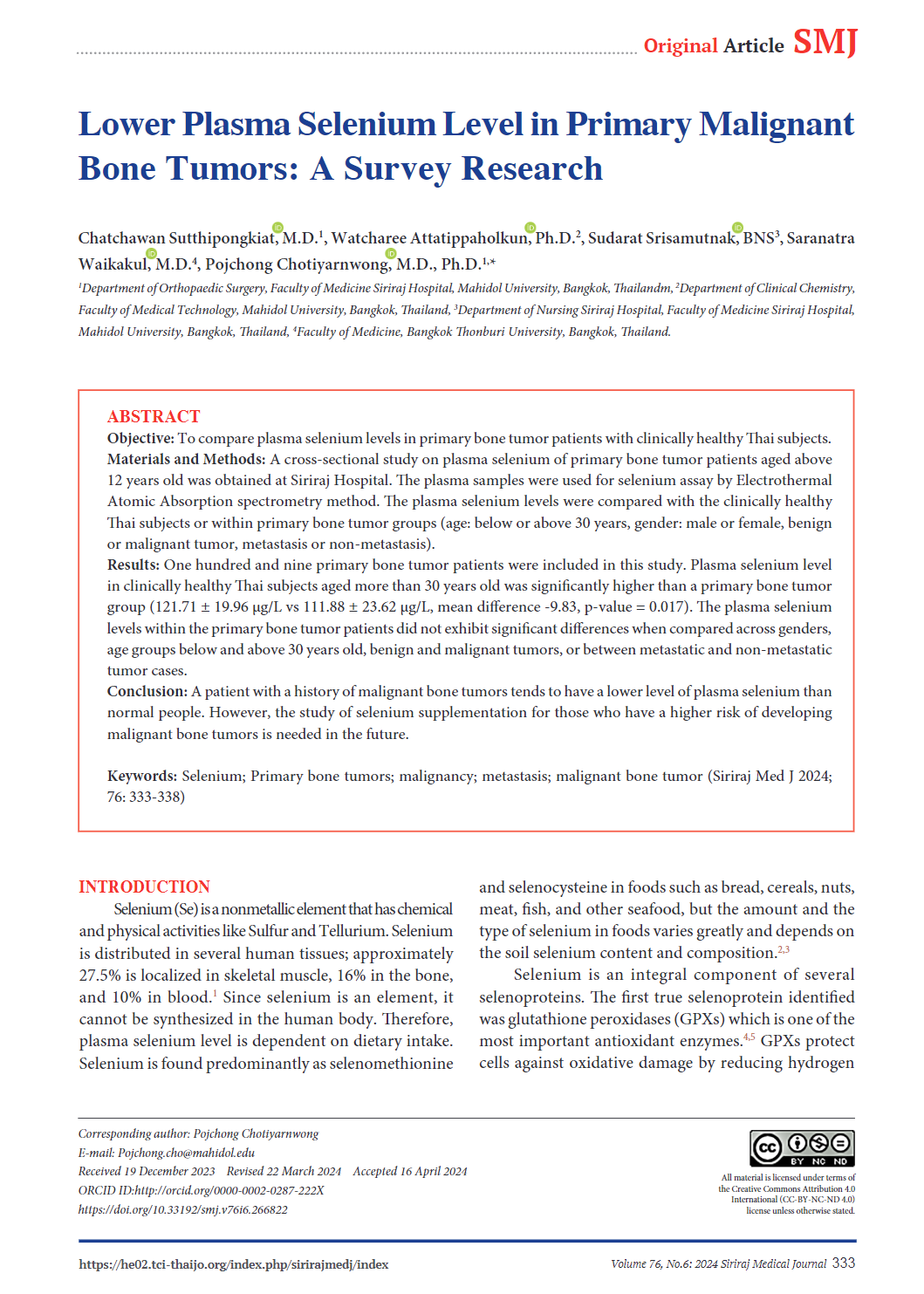Lower Plasma Selenium Level in Primary Malignant Bone Tumors: A Survey Research
DOI:
https://doi.org/10.33192/smj.v76i6.266822Keywords:
Selenium, Primary bone tumors, malignancy, metastasis, malignant bone tumorAbstract
Objective: To compare plasma selenium levels in primary bone tumor patients with clinically healthy Thai subjects.
Materials and Methods: A cross-sectional study on plasma selenium of primary bone tumor patients aged above 12 years old was obtained at Siriraj Hospital. The plasma samples were used for selenium assay by Electrothermal Atomic Absorption spectrometry method. The plasma selenium levels were compared with the clinically healthy Thai subjects or within primary bone tumor groups (age: below or above 30 years, gender: male or female, benign or malignant tumor, metastasis or non-metastasis).
Results: One hundred and nine primary bone tumor patients were included in this study. Plasma selenium level in clinically healthy Thai subjects aged more than 30 years old was significantly higher than a primary bone tumor group (121.71 ± 19.96 g/L vs 111.88 ± 23.62 g/L, mean difference -9.83, p-value = 0.017). The plasma selenium levels within the primary bone tumor patients did not exhibit significant differences when compared across genders, age groups below and above 30 years old, benign and malignant tumors, or between metastatic and non-metastatic tumor cases.
Conclusion: A patient with a history of malignant bone tumors tends to have a lower level of plasma selenium than normal people. However, the study of selenium supplementation for those who have a higher risk of developing malignant bone tumors is needed in the future.
References
Zachara BA, Pawluk H, Bloch-Boguslawska E, Sliwka KM, Korenkiewicz J, Skok Z, Ryc K. Tissue level, distribution, and total body selenium content in healthy and diseased humans in Poland. Arch Environ Health. 2001;56(5):461-6.
Díaz-Alarcón JP, Navarro-Alarcón M, López-García de la Serrana H, López-Martínez MC. Determination of Selenium in Meat Products by Hydride Generation Atomic Absorption SpectrometrySelenium Levels in Meat, Organ Meats, and Sausages in Spain. J Agric Food Chem. 1996;44(6):1494-7.
Tinggi U, Reilly C, Patterson CM. Determination of selenium in foodstuffs using spectrofluorometry and hydride generation atomic absorption spectrometry. J Food Compos Anal. 1992;5(4):269-80.
Holben DH, Smith AM. The diverse role of selenium within selenoproteins: a review. J Am Diet Assoc. 1999;99(7):836-43.
Rotruck JT, Pope AL, Ganther HE, Swanson AB, Hafeman DG, Hoekstra WG. Selenium: biochemical role as a component of glutathione peroxidase. Science. 1973;179(4073):588-90.
Combs GF, Jr., Gray WP. Chemopreventive agents: selenium. Pharmacol Ther. 1998;79(3):179-92.
Rayman MP. The importance of selenium to human health. Lancet. 2000;356(9225):233-41.
Razaghi A, Poorebrahim M, Sarhan D, Bjornstedt M. Selenium stimulates the antitumour immunity: Insights to future research. Eur J Cancer. 2021;155:256-67.
Patrick L. Selenium biochemistry and cancer: a review of the literature. Altern Med Rev. 2004;9(3):239-58.
Knekt P, Marniemi J, Teppo L, Heliovaara M, Aromaa A. Is low selenium status a risk factor for lung cancer? Am J Epidemiol. 1998;148(10):975-82.
Attatippaholkun W, Wikainapakul K, Suwannathon L, Assavamonkolkul A, Tansakul S. Comparison of selenium levels in patient s with osteosarcoma and healthy subjects in Thailand. Thai Cancer J. 2013;33(1):20-7.
Attatippaholkun W, Wikainapakul K, Saelee P. Plasma selenium levels and whole blood glutathione peroxidase activity among Thai breast-cancer patients significantly lower than healthy adult female subjects. Thai Cancer J. 2014;34(4):195-203.
Salonen JT, Salonen R, Lappetelainen R, Maenpaa PH, Alfthan G, Puska P. Risk of cancer in relation to serum concentrations of selenium and vitamins A and E: matched case-control analysis of prospective data. Br Med J (Clin Res Ed). 1985;290(6466):417-20.
Rayman MP. Selenium in cancer prevention: a review of the evidence and mechanism of action. Proc Nutr Soc. 2005;64(4):527-42.
Rautiainen S, Manson JE, Lichtenstein AH, Sesso HD. Dietary supplements and disease prevention - a global overview. Nat Rev Endocrinol. 2016;12(7):407-20.
Vinceti M, Filippini T, Del Giovane C, Dennert G, Zwahlen M, Brinkman M, et al. Selenium for preventing cancer. Cochrane Database Syst Rev. 2018;1(1):CD005195.
Compounds IoMUPoDAaR. Dietary Reference Intakes for Vitamin C, Vitamin E, Selenium, and Carotenoids. Washington (DC): National Academies Press (US); 2000.
Bleys J, Navas-Acien A, Guallar E. Serum selenium levels and all-cause, cancer, and cardiovascular mortality among US adults. Arch Intern Med. 2008;168(4):404-10.

Published
How to Cite
License
Copyright (c) 2024 Siriraj Medical Journal

This work is licensed under a Creative Commons Attribution-NonCommercial-NoDerivatives 4.0 International License.
Authors who publish with this journal agree to the following conditions:
Copyright Transfer
In submitting a manuscript, the authors acknowledge that the work will become the copyrighted property of Siriraj Medical Journal upon publication.
License
Articles are licensed under a Creative Commons Attribution-NonCommercial-NoDerivatives 4.0 International License (CC BY-NC-ND 4.0). This license allows for the sharing of the work for non-commercial purposes with proper attribution to the authors and the journal. However, it does not permit modifications or the creation of derivative works.
Sharing and Access
Authors are encouraged to share their article on their personal or institutional websites and through other non-commercial platforms. Doing so can increase readership and citations.














